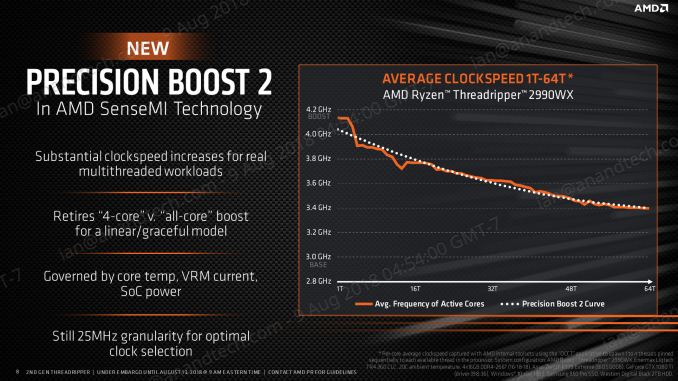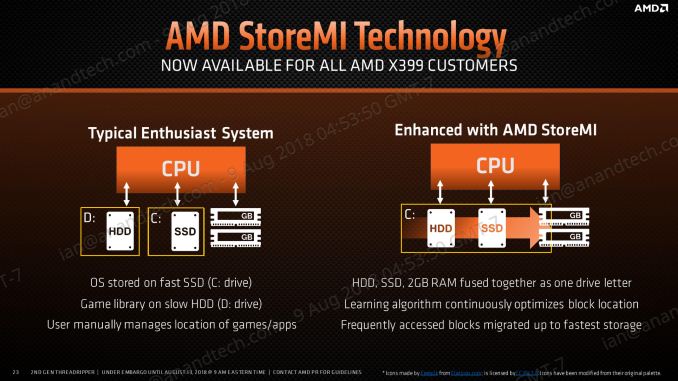The AMD Threadripper 2990WX 32-Core and 2950X 16-Core Review
by Dr. Ian Cutress on August 13, 2018 9:00 AM ESTPrecision Boost 2
Exact per-core turbo timings for the new processors will be determined by AMD’s voltage-frequency scaling functionality through Precision Boost 2. This feature, which we covered extensively in our Ryzen 7 2700X review, relies on available power and current to determine frequency, rather than a discrete look-up-table for voltage and frequency based on loading. Depending on the system default capabilities, the frequency and voltage will dynamically shift in order to use more of the power budget available at any point in the processor loading.
The idea is that the processor can use more of the power budget available to it than a fixed look up table that has to be consistent between all SKUs that are stamped with that number.
Precision Boost 2 also works in conjunction with XFR2 (eXtreme Frequency Range) which reacts to additional thermal headroom. If there is additional thermal budget, driven by a top-line cooler, then the processor is enabled to use more power up to the thermal limit and get additional frequency. AMD claims that a good cooler in a low ambient situation can compute >10% better in selected tests as a result of XFR2.
Ultimately this makes testing Threadripper 2 somewhat difficult. With a turbo table, performance is fixed between the different performance characteristics of each bit of silicon, making power the only differentiator. With PB2 and XF2, no two processors will perform the same. AMD has also hit a bit of a snag with these features, choosing to launch Threadripper 2 during the middle of a heatwave in Europe. Europe is famed for its lack of air conditioning everywhere, and when the ambient temperature is going above 30ºC, this will limit additional performance gains. It means that a review from a Nordic publication might see better results than one from the tropics, quite substantially.
Luckily for us we tested most of our benchmarks while in an air conditioned hotel thanks to Intel’s Data-Centric Innovation Summit which was the week before launch.
Precision Boost Overdrive
The new processors also support a feature called Precision Boost Overdrive, which looks at three key areas for power, thermal design current, and electrical design current. If any of these three areas has additional headroom, then the system will attempt to raise both the frequency and the voltage for increased performance. PBO is a mix of ‘standard’ overclocking, giving an all core boost, but gives a single core frequency uplift along with the support to still keep Precision Boost trying to raise frequency in middle-sized workloads, which is typically lost with a standard overclock. PBO also allows for idle power saving with a standard performance. PBO is enabled through Ryzen Master.
The three key areas are defined by AMD as follows:
- Package (CPU) Power, or PPT: Allowed socket power consumption permitted across the voltage rails supplying the socket
- Thermal Design Current, or TDC: The maximum current that can be delivered by the motherboard voltage regulator after warming to a steady-state temperature
- Electrical Design Current, or EDC: The maximum current that can be delivered by the motherboard voltage regulator in a peak/spike condition
By extending these limits, PBO gives rise for PB2 to have more headroom, letting PB2 push the system harder and further. PBO is quoted by AMD as supplying up to +16% performance beyond the standard.
AMD also clarifies that PBO is pushing the processor beyond the rated specifications and is an overclock: and thus any damage incurred will not be protected by warranty
StoreMI
Also available with the new Ryzen Threadripper 2 processors is StoreMI, AMD’s solution to caching by offering configurable tiered storage for users that want to mix DRAM, SSD, and HDD storage into a single unified platform. The software implementation dynamically adjusts data between up to 2GB of DRAM, up to 256 GB of SSD (NVMe or SATA), and a spinning hard drive to afford the best reading and writing experience when there isn’t enough fast storage.
AMD initially offered this software as a $20 add-on to the Ryzen APU platform, then it became free (up to a 256GB SSD) for the Ryzen 2000-series processors. That offer now extends to Threadripper. AMD’s best case scenario is citing a 90% improvement in loading times.













171 Comments
View All Comments
Lolimaster - Monday, August 13, 2018 - link
I don't really see a point OCing the 2990WX, it seems quite efficient at stock setting with an average of 170w fully loaded, why go all the way to 400w+ for just 30% extra performance, it already destroys the 2950X/7980XE OCed to hell beyond repair.Lolimaster - Monday, August 13, 2018 - link
Threadripper 2990WX = Raid Bossyeeeeman - Monday, August 13, 2018 - link
Amazing performance from AMDs part. If you want to see a real review of 2990WX from a reviewer who understands how this CPU will be used, please check https://www.phoronix.com/scan.php?page=article&...mapesdhs - Monday, August 13, 2018 - link
Figured it would be those guys. 8) I talked to them way back when they started using C-ray for testing, after the original benchmark author handed it over to me for general public usage, though it's kinda spread all over the place since then. Yes, they did a good writeup. It's amusing when elsewhere one will see someone say something like, these CPUs are not best for gaming! Well, oh my, what a surprise, I could never have guessed. :DIn the future though, who knows. Fancy a full D-day simulator with thousands of players? 10 to 20 years from now, CPUs like this might be the norm.
eva02langley - Tuesday, August 14, 2018 - link
It is exactly what I said. If we don't have a proper test bed for a unique product like this, then the results we are going to provide are not going to be representative of the true potential of a CPU like this.Sites will need to update their benchmarks suites, or propose new review systems.
Gideon - Monday, August 13, 2018 - link
Great article overall. The Fabric Power part was the most interesting one! Though you might want to check The Stilt's comments regarding that:https://forums.anandtech.com/threads/2990wx-review...
and:
https://forums.anandtech.com/threads/2990wx-review...
Icehawk - Monday, August 13, 2018 - link
Ian, for in progress articles can they please be labelled that way? I would rather wait for the article to be complete than read just a few pages and have to check back hoping it has been updated.mapesdhs - Monday, August 13, 2018 - link
Ian, can you add C-ray to the multithreaded testing mix please? Becoming quite a popular test these days as it can scale to hundreds of threads. Just run at 8K res using the sphract scene file with a deep recursion depth (at least 8), to give a test that's complicated enough to last a decent amount of time and push out to main RAM a fair bit aswell.abufrejoval - Monday, August 13, 2018 - link
Ok, I understand it we are all enjoying this pay-back moment: Intel getting it on the nose for trying to starve AMD and Nvidia by putting chipsets and GPUs into surplus transistors from process shrinks, transistors that couldn’t do anything meaningful for Excel (thing is: Spreadsheets would actually be ideal for multi-cores even GPGPU, you just need to rewrite them completely…)But actually, this article does its best to prepare y’all for the worst: Twice the cores won’t be twice the value, not this time around, nor the next… or the one after that.
Please take a moment and consider the stark future ahead of us: From now on PCs will be worse than middle class smartphones with ten cores, where it’s cheaper to cut & paste more cores than to think of something useful.
KAlmquist - Monday, August 13, 2018 - link
I'm not sure AMD would have bothered with the 2990WX if it weren't for the Intel Core i9 7980XE. With 18 cores, the 7980XE beats the 16 core Threadripper 2950X pretty much across the board. On the other hand, if you running software that scales well across lots of cores--and you probably are if you're considering shelling out the money for a 7980XE--the 32 core 2990WX will be faster, for about $100 less.These are niche processors; I doubt either of them will sell in enough volume to make a significant difference to the bottom line at Intel or AMD. My guess is that both the 2990WX and the 7980XE were released more for the bragging rights than for the sales revenue they will produce.